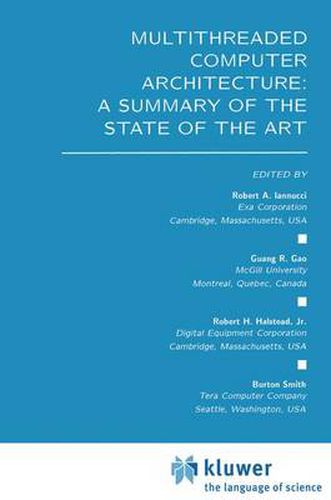Readings Newsletter
Become a Readings Member to make your shopping experience even easier.
Sign in or sign up for free!
You’re not far away from qualifying for FREE standard shipping within Australia
You’ve qualified for FREE standard shipping within Australia
The cart is loading…






This title is printed to order. This book may have been self-published. If so, we cannot guarantee the quality of the content. In the main most books will have gone through the editing process however some may not. We therefore suggest that you be aware of this before ordering this book. If in doubt check either the author or publisher’s details as we are unable to accept any returns unless they are faulty. Please contact us if you have any questions.
Multithreaded computer architecture has emerged as one of the most promising and exciting avenues for the exploitation of parallelism. This new field represents the confluence of several independent research directions which have united over a common set of issues and techniques. Multithreading draws on recent advances in dataflow, RISC, compiling for fine-grained parallel execution, and dynamic resource management. It offers the hope of dramatic performance increases through parallel execution for a broad spectrum of significant applications based on extensions to “traditional’ approaches.
Multithreaded Computer Architecture is divided into four parts, reflecting four major perspectives on the topic. Part I provides the reader with basic background information, definitions, and surveys of work which have in one way or another been pivotal in defining and shaping multithreading as an architectural discipline. Part II examines key elements of multithreading, highlighting the fundamental nature of latency and synchronization. This section presents clever techniques for hiding latency and supporting large synchronization name spaces. Part III looks at three major multithreaded systems, considering issues of machine organization and compilation strategy. Part IV concludes the volume with an analysis of multithreaded architectures, showcasing methodologies and actual measurements.
Multithreaded Computer Architecture: A Summary of the State of the Art is an excellent reference source and may be used as a text for advanced courses on the subject.
$9.00 standard shipping within Australia
FREE standard shipping within Australia for orders over $100.00
Express & International shipping calculated at checkout
This title is printed to order. This book may have been self-published. If so, we cannot guarantee the quality of the content. In the main most books will have gone through the editing process however some may not. We therefore suggest that you be aware of this before ordering this book. If in doubt check either the author or publisher’s details as we are unable to accept any returns unless they are faulty. Please contact us if you have any questions.
Multithreaded computer architecture has emerged as one of the most promising and exciting avenues for the exploitation of parallelism. This new field represents the confluence of several independent research directions which have united over a common set of issues and techniques. Multithreading draws on recent advances in dataflow, RISC, compiling for fine-grained parallel execution, and dynamic resource management. It offers the hope of dramatic performance increases through parallel execution for a broad spectrum of significant applications based on extensions to “traditional’ approaches.
Multithreaded Computer Architecture is divided into four parts, reflecting four major perspectives on the topic. Part I provides the reader with basic background information, definitions, and surveys of work which have in one way or another been pivotal in defining and shaping multithreading as an architectural discipline. Part II examines key elements of multithreading, highlighting the fundamental nature of latency and synchronization. This section presents clever techniques for hiding latency and supporting large synchronization name spaces. Part III looks at three major multithreaded systems, considering issues of machine organization and compilation strategy. Part IV concludes the volume with an analysis of multithreaded architectures, showcasing methodologies and actual measurements.
Multithreaded Computer Architecture: A Summary of the State of the Art is an excellent reference source and may be used as a text for advanced courses on the subject.